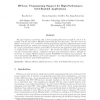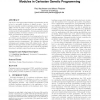1050 search results - page 69 / 210 » Towards programming for the non-technical |
INFOSCALE
2006
ACM
14 years 2 months ago
2006
ACM
Abstract— With the increasing popularity of parallel programming environments such as PC clusters, more and more sequential programmers, with little knowledge about parallel arch...
PDPTA
2003
13 years 10 months ago
2003
The paper begins by considering what a Grid Computing Environment might be, why it is demanded, and how the authors’ HPspmd programming fits into this picture. We then review o...
COMPSAC
2009
IEEE
13 years 9 months ago
2009
IEEE
Modular certification of low-level intermediate representation (IR) programs is one of the key steps of proof-transforming compilation. The major challenges are lexity of abstract ...
GECCO
2008
Springer
13 years 9 months ago
2008
Springer
The choice of an appropriate hardware representation model is key to successful evolution of digital circuits. One of the most popular models is cartesian genetic programming, whi...
AGILEDC
2008
IEEE
14 years 3 months ago
2008
IEEE
Utilizing pair programming in the classroom requires specific classroom management techniques. We have created nine guidelines for successfully implementing pair programming in th...


